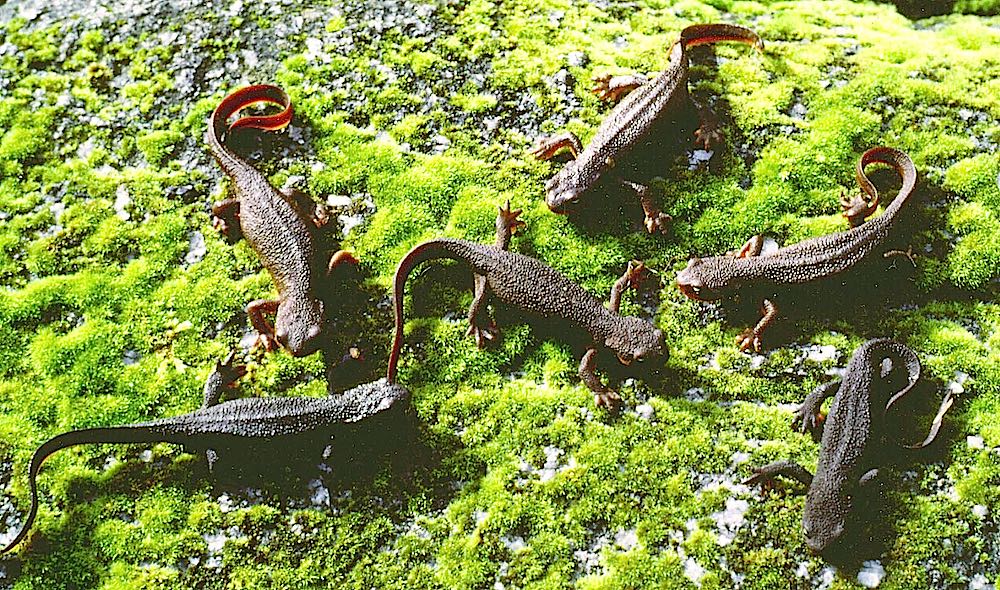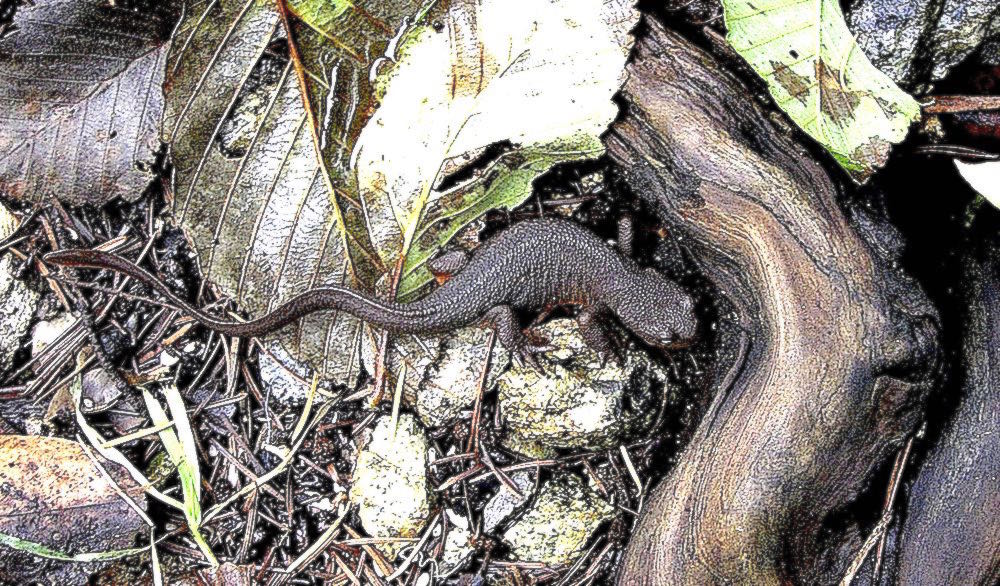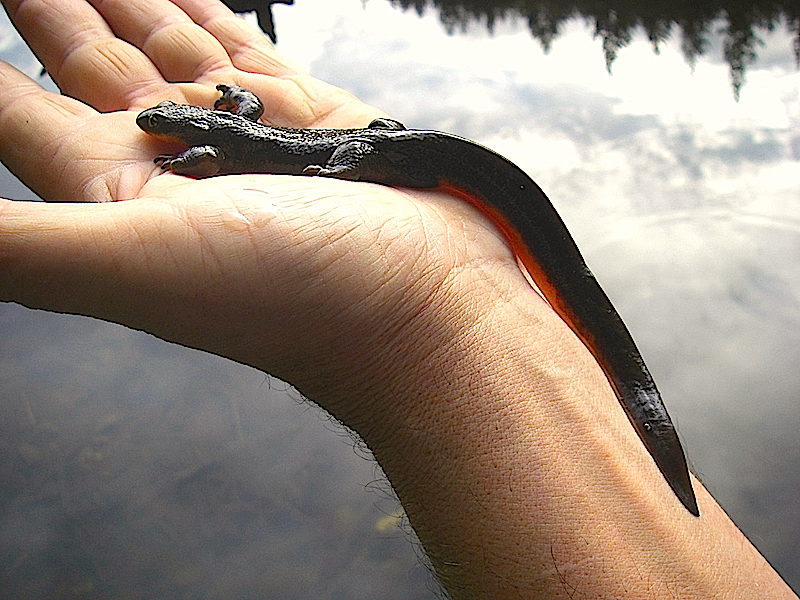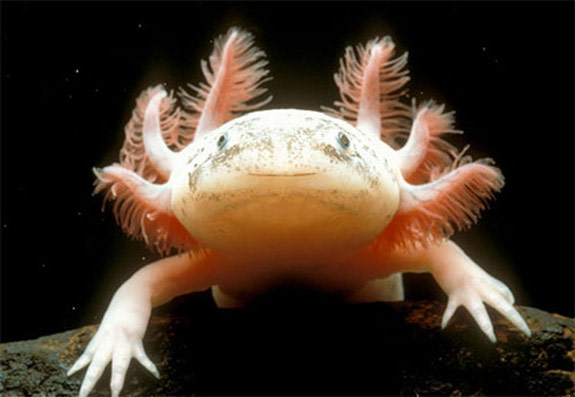(all photographs are author’s, unless indicated otherwise)
The rough-skinned newts (Taricha granulosa) of Cortes Island attract a lot of attention, because, amphibian or not, they are very cute, almost cuddly.

They also get into trouble twice every year, because they are crossing the local roads in several places, either on their way towards their breeding places (ponds and lakes in springtime) or back into their wintering grounds (the forest, in autumn).

Kind souls erect warning signs in appropriate places, to ask drivers to slow down and to keep a very keen eye on the road surface: the newts are small and can be hard to distinguish from a small piece of wood.

In contrast to their drab backs, newts have bright orange undersides. When they feel threatened, they often go into a strange rigour, called the Unken-reflex (after the German word for toad: apparently, many amphibians exhibit this behaviour) where they arch their backs and expose some of their aposematic colouration – the technical term for this phenomenon, designed to warn predators, that the intended prey is bad-tasting or poisonous.

Herpetologists are very interested in the Rough-skinned Newt for a number of reasons: it has been described as the most toxic land-vertebrate in North America! Tetrodotoxin (TTX) levels in the newt’s skin can be high enough to kill a man if he should be careless (or drunk) enough to swallow one. (Events to this effect are well documented: taking water from a pond and making coffee with it, unaware that a hapless newt had been scooped up – or accepting a drunken dare to swallow a newt whole: these are just two fatal examples on record.)
So how can the common garter snake (Thamnophis sirtalis) prey on rough-skinned newts without coming to harm?

First answer: in a classic example of a predator-prey arms race, the snake has developed a tolerance to the TTX of the newt, even though the latter keeps amping up the toxin levels. To cope with this, the Common Garter Snake has evolved the ability to “assay” the rough-skinned newt’s toxicity, by taking a tentative bite and then deciding whether to swallow the newt or not!
Second answer: the above photo was taken on Cortes Island, and our rough-skinned newts are NOT toxic! Great blue herons gorge themselves on our local newts without ill effects, so do other animals. Toxicity levels are highest in Oregon, taper off throughout Washington State, are nearly zero south of the Juan de Fuca Strait and are not detectable on Vancouver Island and the adjacent Gulf Islands. The nearest test result is from Texada Island: no TTX!

Somewhat mean-spirited experiments have been conducted, wherein Vancouver Island Garter Snakes were offered Oregon rough-skinned newts: without hesitation, the snakes swallowed the newts, and without hesitation, the snakes died (so did the newts).

Male newts, it appears, are more aquatic in their habits than females and spend a longer season in ponds or lakes. Every year, come breeding season, they grow an extravagant tail: long and muscular and flattened as an adaptation to efficient swimming: all in the name of chasse la femme.
So powerful can the mating urge become that up to a dozen males may descend upon a female, trying to get hold of her. The result is a “newt-ball” of squirming bodies and flailing tails, with the female struggling hard not to get drowned in the process.

Eventually, as the seasons change, the male’s large tail gets reabsorbed, and the sexes become difficult to distinguish.
We are all familiar with frog tadpoles, though few of us ever noticed the larval stages of newts, perhaps because they don’t occur in conspicuous swarms, or lead more secretive lives, and seldom venture to the water’s surface. This one was inadvertently pulled up with the roots of an aquatic plant.

Unlike frog tadpoles, in newts, the external gills (three branches can be seen to the left of the larva’s head) persist much longer, and, of course, newts never lose their tails.
Indeed, some newt-like amphibians, like the famous Mexican axolotl (Ambystoma mexicanum), keep external gills all their adult lives (a phenomenon known as neoteny).

Rough-skinned newts are yellow-listed, i.e. their status is deemed secure. They are, nonetheless, protected under the Wildlife Act.
The differences between newts and salamanders are subtle (like the differences between frogs and toads). Newts tend to be more aquatic than salamanders, which is reflected in the flat tails of newts (adapted to swimming), while salamanders have round tails. The former also tend to have rougher skin than the latter.
*****************
Another member of the Salamandridae, and a true Salamander at that, is the wandering salamander (Aneides vagrans), which can be found on Marina Island. Its story is told here.




One Response
Thank you for sharing such amazing pictures. They are so beautiful and makes me slow down to pause.
sj